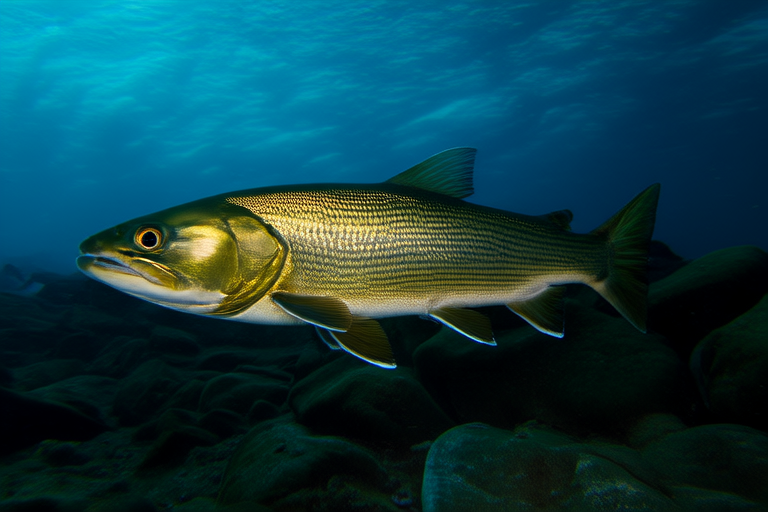From Lake Tanganyika to Your Tank: The Thrilling Journey of the Rajah Cichlid
The world of freshwater aquariums is vast and diverse, offering countless species of fish to captivate and challenge aquarists. Among these, the Rajah Cichlid (Boulengerochromis microlepis) stands out as a unique and captivating species. Originating from the depths of Lake Tanganyika, one of the oldest and deepest lakes in the world, the Rajah Cichlid is a testament to the incredible biodiversity that thrives within this aquatic ecosystem. This article will guide you through the journey of the Rajah Cichlid, from its natural habitat to your home aquarium, providing insights into its behavior, dietary needs, and the challenges and rewards of keeping this species.
Natural Habitat and Unique Characteristics
Lake Tanganyika, located in East Africa, is renowned for its remarkable biodiversity. It is home to over 200 species of cichlids, many of which have adapted to specific niches within the lake’s varied environments. The Rajah Cichlid, known for its striking appearance and complex social behaviors, is found in the deeper waters of the lake, where it thrives in rocky crevices and sandy bottoms.
One of the most distinctive features of the Rajah Cichlid is its elongated body, which can grow up to 40 cm in length. Its coloration varies, but typically consists of a silvery base with darker spots or stripes, providing excellent camouflage against predators. The fish’s large eyes and mouth are well-suited for its predatory lifestyle, allowing it to spot and capture prey in the dimly lit depths of Lake Tanganyika.
Behavior and Diet
Rajah Cichlids are piscivorous, meaning their diet primarily consists of other fish. In the wild, they hunt smaller fish, utilizing their keen eyesight and swift movements to catch their prey. In captivity, it is essential to provide them with a similar diet, such as live or frozen fish, to maintain their health and vitality.
These cichlids are generally territorial and can be aggressive towards other fish, especially those of similar size. They exhibit complex social behaviors, often forming hierarchies within groups. Aquarists should be mindful of these behaviors when selecting tank mates, ensuring that there are no conflicts that could harm the Rajah Cichlids or other inhabitants.
Ideal Tank Conditions
To thrive in captivity, Rajah Cichlids require specific environmental conditions that mimic their natural habitat. A large aquarium, preferably 100 gallons or more, is necessary to accommodate their size and swimming patterns. The water temperature should be maintained between 75°F and 82°F, with a pH level around 7.5 to 9.0. Regular water changes and efficient filtration systems are crucial to maintaining water quality and preventing ammonia and nitrite levels from rising.
Providing ample hiding places and caves made from rocks or driftwood can help reduce stress and promote natural behaviors. These structures also serve as breeding sites, encouraging reproductive activities in the aquarium setting. Lighting should be moderate, replicating the low light conditions found at the bottom of Lake Tanganyika.
Breeding Rajah Cichlids
Successfully breeding Rajah Cichlids requires careful planning and attention to detail. Pair formation is critical; ideally, select a male and female pair that shows compatibility. Once paired, provide a suitable breeding site, such as a cave or a sheltered area within the tank. The female will lay eggs on a flat surface inside the cave, and the male will fertilize them.
After spawning, the parents will guard the eggs and newly hatched fry. The eggs typically hatch within 3 to 4 days, and the fry will be free-swimming shortly after. At this stage, it is advisable to separate the fry into a dedicated rearing tank to ensure they receive adequate nutrition and protection from adult fish. Feed the fry with infusoria or finely crushed flake food initially, gradually transitioning to larger foods as they grow.
Common Challenges and Solutions
Caring for Rajah Cichlids presents several challenges, particularly for novice aquarists. One common issue is aggression among tank mates. To mitigate this, ensure that the aquarium is spacious enough to allow all fish sufficient territory. Additionally, introducing fish simultaneously or adding new fish gradually can help establish a peaceful hierarchy.
Another challenge is maintaining water quality. Regular monitoring of water parameters and timely water changes are vital to prevent diseases and ensure optimal health. Investing in high-quality filtration systems and regular maintenance routines can significantly enhance water quality and fish health.
The Fascination of Rajah Cichlids
The Rajah Cichlid is a captivating addition to any advanced aquarium setup. Its unique appearance, combined with its intriguing behaviors and challenges, makes it a rewarding species for experienced aquarists. By understanding and meeting the specific needs of this species, aquarists can create a thriving environment that showcases the beauty and complexity of life in Lake Tanganyika.
In conclusion, the journey of the Rajah Cichlid from its natural habitat to your tank is a testament to the wonders of aquatic biodiversity. By providing the right conditions and care, aquarists can enjoy the thrill of observing these magnificent fish in their home aquariums. Whether you’re a novice or an experienced aquarist, the Rajah Cichlid offers a fascinating and enriching experience that highlights the importance of responsible and informed fishkeeping.
